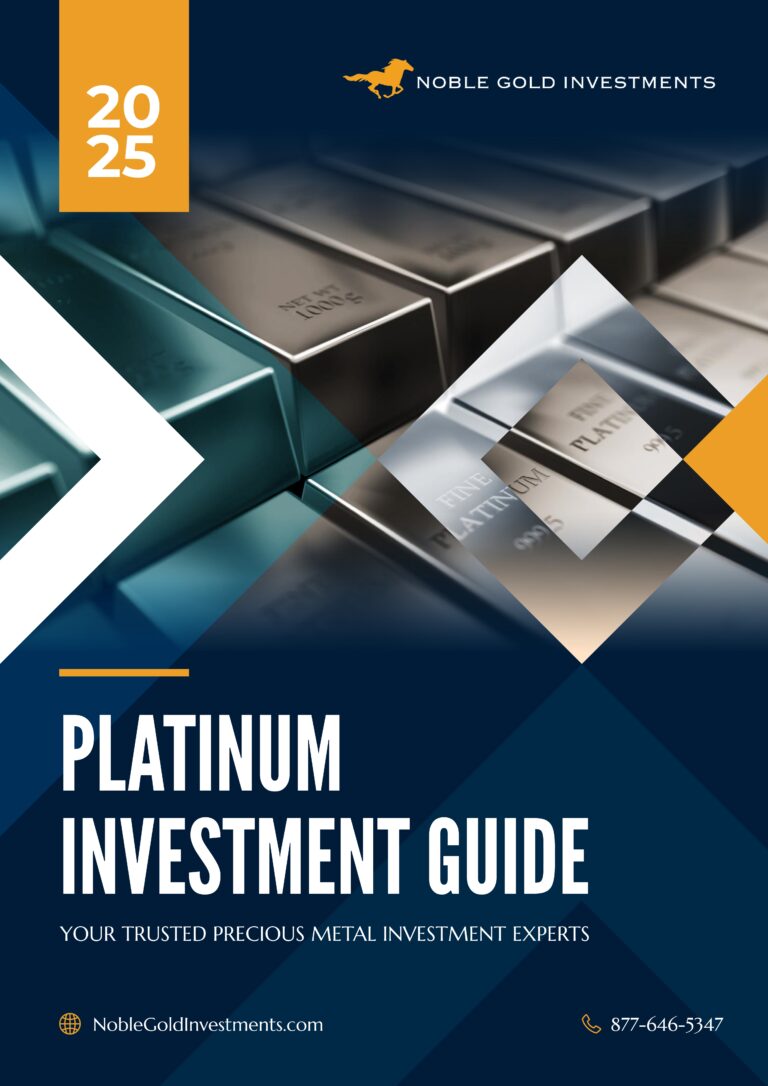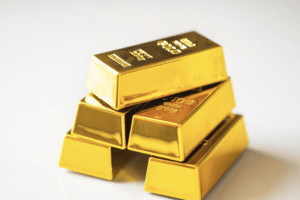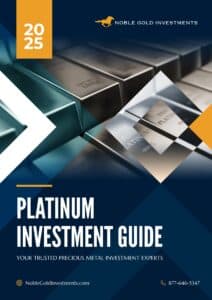From platinum credit cards to platinum records, platinum has long signified superiority. Despite that fact, platinum has consistently been a less popular investment than gold or silver. If you’re like many people turning to precious metals for security, you may wonder: Is platinum a good investment?
The answer depends on your goals and circumstances. Here, we’ll take a look at how to invest in platinum and how to determine whether it’s the right precious metal investment for you.
Understanding Platinum as a Precious Metal
If you’re considering platinum as an investment, it’s a good idea to first take a moment to get acquainted with this rare and versatile precious metal.
The Unique Characteristics of Platinum
Platinum is a dense, strong metal with a shiny, silvery-white color. Out of all the Earth’s elements, only iridium and osmium are denser.
However, despite its density, platinum is surprisingly easy to work with. It’s highly malleable and ductile (meaning it can be pulled into very thin wires). As one of the “noble metals,” it does not react easily. In practical terms, that means that it’s extremely resistant to tarnish and corrosion.
Platinum is also extremely resistant to heat. It has a melting point of 3,215°F. (For the sake of comparison, gold’s melting point is 1,945°F).
Many people know that platinum is often used in high-end jewelry, but because of its unique properties, it has a number of other uses as well. Most of the demand for platinum comes from these four sectors:
- Automotive: 40%
- Industrial: 24%
- Jewelry: 30%
- Investment: 6%
Because it’s extremely resistant to heat and corrosion, works as an effective catalyst, and conducts electricity efficiently, platinum is in high demand across multiple industries. These are some of its most common uses:
Pacemakers and Other Biomedical Devices
As a noble metal, platinum is generally non-reactive. It won’t react with any human tissues, and it’s also hypoallergenic. These properties make it a safe choice for stents, catheters, pacemakers, and various other kinds of biomedical devices.
Catalytic Converters
This is one of platinum’s best-known uses. Because it’s an effective catalyst, platinum is used as a coating on the inside of catalytic converters. The platinum accelerates the chemical reaction between oxygen and carbon monoxide (as well as the reaction between oxygen and harmful “greenhouse gases”). These chemical reactions reduce the amount of potentially harmful chemicals the vehicle releases into the air.
Petroleum and Oil Refining
In the petroleum and oil refining industries, platinum’s catalytic properties “crack” low-grade fuel into more refined forms. For example, platinum can be used to transform naphtha (a volatile mixture of petrochemicals) to gasoline.
Glass Manufacturing
It can be difficult to find tools that will handle the process of glass manufacturing. They must be able to withstand temperatures of 2,000°F or more, and they must not damage or interact with any chemicals used in the process. Platinum is one of the few materials that fit the bill.
Catalyst in the Chemical Industry
Platinum’s exceptional catalytic abilities aren’t just useful for the auto industry. Because catalysts can speed up many kinds of chemical reactions, platinum is used to produce fertilizer, plastics, and many other products.
Electronics
Platinum is durable and easy to work with, and it also conducts electricity well. It’s often used as a component in capacitors, electrodes, and other parts of electronic devices.
Jewelry
Platinum is durable and has a striking luster. Its density means that when it is used as a setting for a diamond or other stone, it holds the stone more securely. Unlike silver or white gold pieces with rhodium plating, platinum maintains its silver-white color for life.
Historical Trends in the Platinum Market
In the mid-1970s, tightening emissions standards led to the use of platinum in catalytic converters. This drove up the price of platinum, and it also established car manufacturers as one of the greatest sources of demand.
Platinum’s price continued to grow, and a perfect storm of factors (including supply disruption, market speculation, and increasing demand from car manufacturers) led to a major spike in price right before the 2008 recession. At this point, platinum crashed.
After this low point, platinum’s prices gradually rebounded until the early 2010s. At that moment, two factors drove its value back down. The most significant factor was the introduction of palladium, which many automakers began to use preferentially to make catalytic converters for gas-powered cars.
Platinum was still the material of choice for catalytic converters in diesel cars, but unfortunately, 2015’s “Dieselgate” scandal eroded public trust in diesel vehicles, lowering demand.
“Dieselgate” came about because Volkswagen installed so-called “defeat devices” on many of its diesel vehicles. These devices were designed to cheat emissions tests. As a result, the Volkswagen vehicles passed emissions tests despite emitting massive amounts of pollution.
Although platinum prices sharply declined at the start of the COVID-19 pandemic, they have recovered since then, and renewed demand for clean energy (coupled with platinum supply deficits) has driven prices up further.
The Case for Platinum Investment
Some people who are considering investing in platinum are deterred by its volatility. However, if you’re hoping to buy low and sell high, several factors are pointing to the possibility of an oncoming surge in price.
Many economists believe that platinum is seriously undervalued and that a price correction is imminent. A look back through platinum’s price history suggests that they are right.
Historically, platinum’s value has been similar to (or even greater than) that of gold. In the past 40 years, there have been only four times when platinum was cheaper. In the current market, we’ve seen an extended period where gold is far more expensive.
When you look at the bigger picture, it’s clear that platinum’s low price relative to gold is the exception, not the rule. That means there’s significant potential for platinum’s value to swing up.
There’s no way to predict what the market will do with absolute certainty, but for platinum, the forecast looks promising, and that’s not the only point in the shiny metal’s favor.
Is Investing in Platinum a Good Strategy?
Is platinum a good investment? That depends on your needs, but to determine whether a platinum investment is right for you, it’s important to understand what sets it apart from other precious metals (and especially gold).
Gold is one of the most common “safe-haven” assets. Safe-haven assets are assets that investors often choose to provide security during times of economic upheaval. Because these assets usually maintain their value (or even appreciate) during market downturns, they are seen as a way to protect and preserve wealth. They tend to be relatively stable over time.
Many people tend to assume that precious metals are safe-haven assets. However, gold’s status as a safe-haven asset is partly based on its history. Throughout human history, civilizations have respected this metal’s intrinsic value. It’s a safe investment because no matter what the market does, gold will always be seen as valuable.
Platinum’s primary value is as an industrial metal, so its price can fluctuate considerably depending on market forces. That makes it more volatile than gold, and its lack of predictability means it doesn’t have the same status as a safe-haven asset.
However, the fact that platinum isn’t a traditional safe-haven asset doesn’t mean it’s a bad investment. Depending on your situation in life and your current goals as an investor, it may actually be preferable.
Why? Safe-haven assets like gold are generally stable, so while they don’t lose value, they also tend to generate very modest returns. Platinum’s volatility makes it a higher risk investment, but that means there’s the potential for a higher reward, too.
Any experienced investor knows that a diversified portfolio is a stable portfolio, and if you’re looking to diversify, incorporating platinum could be a smart strategy. To help protect yourself from market risk, it’s wise to include investments that aren’t closely correlated with other major asset classes.
Platinum isn’t closely tied to the performance of stocks and bonds. This means that in the event of a major stock market downturn, the platinum in your portfolio would be more likely to hold its value.
Potential for Value Appreciation
Many advocates of platinum as an investment point to its high potential for future value appreciation. To understand this metal’s potential for increasing value, you first need to grasp some of the primary factors influencing its price:
- Industrial Demand: The more in-demand platinum is as an industrial metal, the higher its price is likely to go
- Supply Disruptions: Historically, constrictions in the platinum supply chain have caused dramatic price spikes
- Recycling: When very little platinum is recycled, supply drops and prices rise
- Broader Market Dynamics: During economic booms, industrial demand for platinum generally increases
Growth in the green energy sector is already increasing the demand for platinum. As a catalyst, platinum is an important component in hydrogen fuel cells. These fuel cells can produce zero-emission energy, and in the coming decade, demand for them will likely increase. Hydrogen fuel cells have already been used successfully in vehicles, and they could potentially be used to power industrial operations in the future.
As demand for platinum increases in the future, its general scarcity may drive prices up even further. You may have heard the oft-cited statistic that platinum is 30 times rarer than gold. Platinum mining is less common and has a much shorter history, so the amount of above-ground platinum is far less than the amount of gold.
Current Market Dynamics
Before you invest in platinum, it’s wise to understand how it fits into the precious metals market. While platinum is a precious metal like silver or gold, its unique characteristics mean that it doesn’t always perform the same way that these metals do.
Why Is Platinum Priced Lower Than Other Precious Metals?
In some circles (like the jewelry world), platinum is regarded as the most precious metal of all. However, if you’ve been keeping an eye on the precious metals market, you already know that the price of gold eclipses that of platinum. (In August 2025, the price of gold per troy ounce was more than double that of platinum).
Why is this? The short answer is that platinum is a far more volatile investment. There are a number of reasons :
- Because of its industrial uses, platinum’s value can shift with the performance of other sectors
- The concentration of most platinum mining in South Africa and Russia makes it vulnerable to geopolitical instability
- Generally, there’s greater investment demand for gold, silver, and other “mainstream” precious metals
There’s another major reason platinum’s price is so much lower than you might expect: palladium. Historically, platinum prices have been strongly tied to industrial demand. Within the last decade, automakers discovered that in gasoline-powered cars, palladium was a better material than platinum for catalytic converters.
In the year 2017, the price of palladium surpassed that of platinum, and eventually, palladium’s price per troy ounce was twice that of platinum’s.
However, in recent years, platinum prices have been on the rebound. This is largely because, at the moment, platinum demand exceeds supply. The World Platinum Investment Council (WPIC) notes that 2025 is the third straight year that there has been a supply deficit of platinum.
South Africa is responsible for about half of the world’s platinum production, and in early 2025, the majority of its platinum mines failed to perform as expected. The combination of a long-standing shortfall and a sudden, unexpected decrease in production drove prices up.
In a roundabout way, palladium is helping to fuel platinum’s comeback. As palladium prices have soared, some car manufacturers have switched back to using the now-cheaper platinum in their catalytic converters.
Does Platinum Maintain Its Value During Economic Uncertainty?
These are uncertain times, so if you’re thinking about investing in platinum, you might (understandably) want to know whether platinum will hold onto its value in the event of a market downturn.
Unfortunately, there’s not a simple, yes-or-no answer to that question. Unlike gold, platinum isn’t a primary safe-haven asset, and its historical volatility makes its performance during uncertain times difficult to predict.
Because platinum prices are often driven by industrial demand, the metal’s value will often drop during market downturns. But its value can (and does) rebound, even from historic lows.
A prime example is platinum’s performance during and after the COVID-19 pandemic. As economies slowed in 2020 and early 2021, platinum’s price took a nosedive below $600. However, once economic activity resumed, it rebounded to more than $1,200 per ounce. In July 2025, it surged to more than $1,400.
In 2008, platinum’s spike and crash were even more dramatic. Early in the year, before the infamous 2008 recession had taken hold, platinum was priced at an astounding $2,240 per ounce.
The spike was largely driven by supply chain disruptions in Russia and South Africa. Car manufacturers began stockpiling platinum for catalytic converter manufacturing.
However, during the 2008 recession, automakers were among the hardest hit. The demand for platinum crashed, and so did its price. By the end of 2008, platinum was valued at under $700 per ounce.
The takeaway here is that while platinum’s value generally doesn’t hold steady through economic downturns, it almost always rebounds.
How to Invest in Platinum
There are multiple ways to purchase platinum as an investment. Before you dive in, it’s important to take the time to analyze your options and develop a plan. No investment should be made in a vacuum, and it’s critical to make sure that platinum fits with the rest of your investment portfolio and aligns with your goals.
If you can’t decide whether platinum is the right investment choice for you, a financial professional may be able to offer guidance and insight.
Once you’ve made the decision to invest in platinum, you’ll need to determine what kind of investment you want to make.
Exploring Different Investment Options
Wondering how to invest in platinum? You have a few different options, but these three are the most common:
- Physical platinum
- Platinum exchange-traded funds (ETFs)
- Platinum stocks
Investing in physical platinum is generally the most straightforward option. Much like gold, platinum bullion can be purchased in various forms. These include bars, bullion coins, rounds (platinum coins made by private, non-government mints), and ingots (pieces cast into a particular shape).
Before purchasing the physical metal, make sure to consider the cost and logistics of storage. Many investors keep platinum bullion in safe deposit boxes, but some opt to keep it in secure storage facilities.
Some people choose to purchase unique, collectible items made from platinum (like rare coins) as investment pieces. These items usually have additional value beyond the price of the metal alone.
If you’re interested in platinum as an investment but want something with a little more liquidity, you might consider platinum ETFs as an alternative. When you invest your money in a particular platinum ETF, your investment is spread out across multiple platinum-backed securities. These often include mining companies and even physical platinum bars.
ETFs help you manage risk by automatically diversifying your investment. However, when you invest in a given fund, you’ll be charged an expense ratio.
If you don’t want to invest through an ETF, you might choose to invest in individual platinum stocks yourself. These might include specific platinum mining company stocks. It’s a viable strategy, but keep in mind that on any stock exchange, there will be far more gold stocks than platinum stocks.
Practical Tips for Buying Platinum
Investing in platinum can be an exciting journey, but it’s not without risk. To maximize your chances of a successful experience, keep these tips in mind:
Weigh the Pros and Cons of Each Option
Physical platinum, platinum ETFs, and individual stocks all come with advantages and disadvantages. When weighing your options, make sure you thoroughly understand each one.
Focus on the Long-Term
Don’t be discouraged by short-term volatility. It’s easy to panic over slight fluctuations, but these are a reality with most kinds of investments. When you understand how your platinum investment fits into your long-term investment strategy, it will be easier to stay the course.
Diversify
Some investors do their research, identify a promising investment, and then over-commit to it. However, no matter how confident you are in a given investment, there’s always risk. Maintaining a balanced portfolio is the best way to keep that risk manageable.
Follow the Market
Staying on top of market trends will help you decide when to buy and sell. Because platinum is an industrial metal, some investors generate respectable returns by purchasing platinum during market downturns (when prices are low) and then selling during economic booms.
Although you can’t see into the future, being familiar with market trends can help you learn to predict shifts in the price of platinum and other precious metals.
Buy From Reputable Dealers
If you’re buying physical platinum, choose an established dealer. Unfortunately, precious metals fraud schemes are more common than many people realize. If you lose money in a scam, it may be difficult or impossible to recover it.
Consult a Professional
It’s also wise to consult a financial advisor or other financial professional before embarking on your platinum investment journey. Your advisor can help you determine how your platinum investment fits in with your long-term investment strategy.
Is Platinum Right for Your Investment Portfolio?
There’s no one-size-fits-all answer to the question of whether you should invest in platinum. The current state of your portfolio, your financial goals, your risk tolerance, and other factors all come into play.
Before you make your decision, it’s essential to carefully weigh the risks and benefits. For many investors, that means balancing platinum’s potential volatility with the benefits of diversification.
You don’t have to make your investment decision alone. At Noble Gold, we’ve spent more than 20 years helping clients discover the security that comes with precious metals investments. If you’re considering investing in platinum, get in touch with us to schedule a complimentary investing strategy session.







